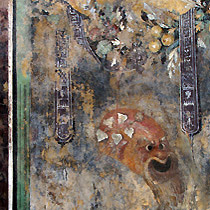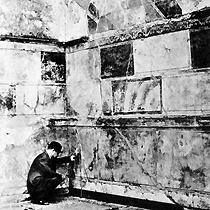 6>
6>Imitation Marble to Metaphysical Worlds
Having discussed some of the issues surrounding Roman domestically located wall-painting, it is now time to examine the actual paintings themselves. Not surprisingly the locations in which they were discovered mirror Roman colonization, fragments having been found as far afield as Jordan, Africa and England. In contrast to their geographic diversity, the wall-paintings exhibit some remarkably similar characteristics. Although compositionally quite varied, they all tend to possess an astonishingly sophisticated understanding of pictorial space and its relationship to its immediate environment. So much so that August Mau was able to use this characteristic as the basis for his four style classification of Pompeian painting, which later came to represent all Roman wall-painting in a way that has been both enlightening and problematical.
Many of the problems have stemmed from the fact that a ‘style’ is usually identified by the distinguishing features by which it is collectively determined and, therefore, all the characteristics that make it different are consistently emphasised. Not only does this make 'style' appear autonomous, but it also encourages the search for further examples of stylistic difference, rather than synergy. This is precisely what happened to August Mau’s Four Style typology. Instead of questioning it, those that followed tried to use iconographic similarities as a way of identifying ever more subtle transitional phases in between the four styles. Their quest for typological knowledge, as opposed to semantic, invariably stressed further visual differences at the expense of underlying synergies. (For a detailed account of Mau's Four Styles and subsequent attempts to identify intermediary phases or even phases within phases see "Domestic Decoration, Painting and the "Four Styles" " by Volker Michael Strocka in The World of Pompeii, eds. Dobbins and Foss, . Particularly page which lists phases within the Second Style, the first of which contains 3 sub-phases and the second sub-phases.)
If instead of difference we look for synergy a less stylistic model of Roman wall-painting emerges. If we map these synergies onto Mau’s Four Style classification, iconographic difference becomes less obvious as compositional features increasingly overlap. According to the status quo Mau’s Incrustation (First) Style is defined as paint imitating marble (fig.1). In stark contrast to this planar characteristic the Architectural (Second), Ornate (Third) and Intricate (Fourth) Styles (Mau's classifications), are described in terms of a spatial paradigm shift towards incorporating complex architectural features, pictorial inserts and ornamental motifs (fig.2-5). In terms of emphasis, this is undoubtedly the case, but at the same time much of the iconography just described occurs across all three styles and there are also several examples in the First Style of objects appearing to hang on the faux marble wall, thus adding a spatial dimension that connects it to the other styles (fig.6). In addition, all four 'styles' emphasised lateral and vertical divisions constructed from pilasters, columns, entablatures and aediculae, which further undermines secure chronological classification.
However, in the absence of an alternative, Mau's classification remains the most cited, if only as a method for highlighting the way in which pictorial space in Roman wall-painting modulates between spatial and planar characteristics. Karl Schefold considered these modulations to be analogues to the Classical, Mannerist and Baroque periods in Renaissance art, with each period equating to the Second, Third and Fourth Styles (La Peinture De Pompéi – Témoignages de l’art romain dans la zone ensevelie par Vésuve en 79 ap. J.C., 1999, pp.35-36.) He and other writers such as Josef Engemann also saw all the individual elements in Roman painting as being of Greek origin. (Engemann 1967) Although Schefold, in particular, stressed the degree to which Roman artists synthesised Greek influences into new spatial and conceptual forms that were distinctively Roman. (Schefold 1962)
2 Villa di Poppea, cubiculum 11, Oplontis
3 (a) Casa di M Lucretius Fronto, (b) Villa di Agrippa Postumo, Boscotrecase
4 Casa di Ara Maxima, room F, Pompeii
5 Fragments of Styles 1-4, Kunsthistorische Bilderbogen, Verlag E. A. Seemann, Leipzig, 1883
6 First Style with emblemata – garland, fillet (betrothal scarf) and mask, Museo Archeologico Regionale, Palermo
 1
1
|